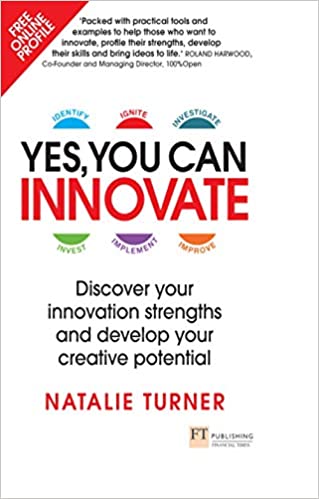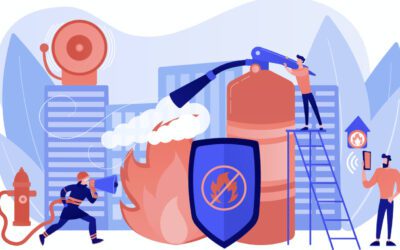A Mindset for Winners of a Crisis
Before you jump right in and possibly lose yourself in blind actionism, you should give a thought to the correct mindset, which helps tremendously towards getting your actions in a clear line. For this, we recommend the book by Natalie Turner: Yes, You Can Innovate, whose key points we are happy to share here.
In times of good business it is nice to be happy about it and to pat each other on the back but due to the global interconnectedness of the world, an abundance of processes correlate with each other so that the next crisis will surely occur at some point. Therefore, it is of utmost importance to optimize the initial conditions for an emergency situation in advance.
Any solutions to a crisis require creativity, flexibility and innovation. All of this can only be achieved in an environment where diversity is lived and individualism is given high priority. Rigidly conformist and simple-minded thinking is steered in new directions, where a free space for individual responsibility arises. Anyone who wants to thrive must make the decision now to exchange outdated conventions for courageous innovations. This is the path from orderly negligence to confident decision-making. And for this turnaround to succeed, something has to change in the minds of everyone involved. Natalie Turner calls it the Six ‘I’s which are all interlinked with the central purpose that has to be kept in mind:
- Identifying: spotting both opportunities and aspects to be ameliorated creates a capacity for new ideas
- Igniting: cultivating & nurturing new ideas which may serve customers’ needs or a new trend
- Investigating: exploring the fresh ideas by experimenting and analyzing feedback
- Investing: once approved, an idea needs funding not only with money but also with resources like time and energy
- Implementing: executing the new plans and ideas in an innovative way
- Improving: repeated reviews of the product or service and adapting where needed
This new mindset may involve a more or less radical shift within the mindset of many, but it’s worth making the effort. If you would like more inspiration on this, you might have a look at the entire book. It does not stop at the Six ‘I’s but includes hands-on, practical advice with tests and assessments. The full topic of resilience in business leaders is focused in one of our other articles as well: Are you a resilient business manager?.

Yes, You Can Innovate: Discover your innovation strengths and develop your creative potential
Author: Natalie Turner
Publisher: Pearson Business
Published: March 2nd, 2018
Yes You Can Innovate is a practical how-to guide to help you discover your innovation strengths. It comes with free self-assessment tools so you can improve your ideation processes and find the mindset that lets you navigate a crisis with more ease. There’s something for everybody in there, pick your personal lifeline.
The book is available on Amazon for €19.99.
“
If you take the opportunity out of the crisis – it becomes a threat. If you take the fear out of the crisis – it becomes an opportunity.
Anja Förster & Peter Kreuz in “Don’t Waste a Crisis” (orig: Vergeude Keine Krise)
”
1. Identify the Risks
Let’s be honest – are you aware of all the risks that could affect your company in the event of social, political, global, financial or technological upheaval? In other words, which of the risks that you recognize have you ever simulated from start to finish; taken a look at the various parameters, developed an analysis and a strategy of action? The pandemic has shown us very clearly how much more emphasis must be placed on crisis management in business models in order to remain capable even in the event of an emergency.
Such crisis prevention is based on a precise analysis of various scenarios. For this purpose, it is useful to apply all possible outcomes of these scenarios to your company and to find out which ones are of central importance for you. For this there are various departments in the company that take care of their own specific areas; Enterprise Risk Management, uses various parameters to evaluate both strategic and operational risks, Compliance Management investigates legal factors, while Sustainability Management determines sustainability risks and the internal control system examines the process flow for risks.
As we can see, these areas are quite distinct, but they are all more or less interrelated because rarely does a problem affect just one aspect; often several interacting points of reference are involved.
2. Minimize the Risks
What effective crisis management requires is an integrated view of all the risk factors in the various areas. After all, the outcome of a risk can of course be assessed as marginally relevant when viewed in isolation, but it is only in the concrete, interrelated structure that a potentially serious effect arises which may become a threat in a crisis. We tend to assess what is known as less imminent. However, you should be aware of this subconscious assessment when it comes to risk assessment. Just because we know the danger doesn’t mean it can have less serious consequences in reality.
This holistic and objective assessment is successful if the different departments cooperate – each is expert in its own area, but at the same time gains a deeper understanding of the processes and risk factors from other areas and can bring new perspectives to the table. Such loose collaborations are a great solution when it comes to short-term action, but in the long run, it needs to become a solid organization that serves as the basis for risk management and thus sustains crisis prevention.
Within this organization, the goal must be to calculate profitability based on real numbers, focusing on both the best-case and worst-case crisis scenarios. In order to make better decisions, it is necessary to agree on risk factors, which, in conjunction with predefined key figures and qualitative aspects, allow for more well-founded scenarios. In addition, a decision tree can be created in advance on the basis of these scenarios, which increases the freedom of action in the respective situation, because it is much more difficult to act clearly and with a firm grasp of the facts when under pressure. These strategies make it much easier to recognize which decisions are likely to have which consequences.
3. Perform Regular Revisions
This last step is simultaneously the first step. It is by no means just a matter of meeting regulatory requirements, drawing up a plan for the crisis and then twiddling your thumbs. Instead, the focus must be on the safe continuation of the company’s business activities. To do this, we need to recognize that we are operating in an environment that will certainly not become less risky in the coming years as a result of strong global interdependence.
* All links marked with (*) are affiliate links. This means that I may receive a small commission if you purchase the advertised product through this link.
Once again, this means always keeping an eye on current changes in the world of technology, politics and business, regularly reviewing the different areas and possibly eliminating or exploiting new potential correlations, risks or a crisis in advance. We can clearly conclude that a holistic, forward-looking approach with a coherent purpose and the right mindset are the key elements in crisis prevention and risk management.




0 Comments